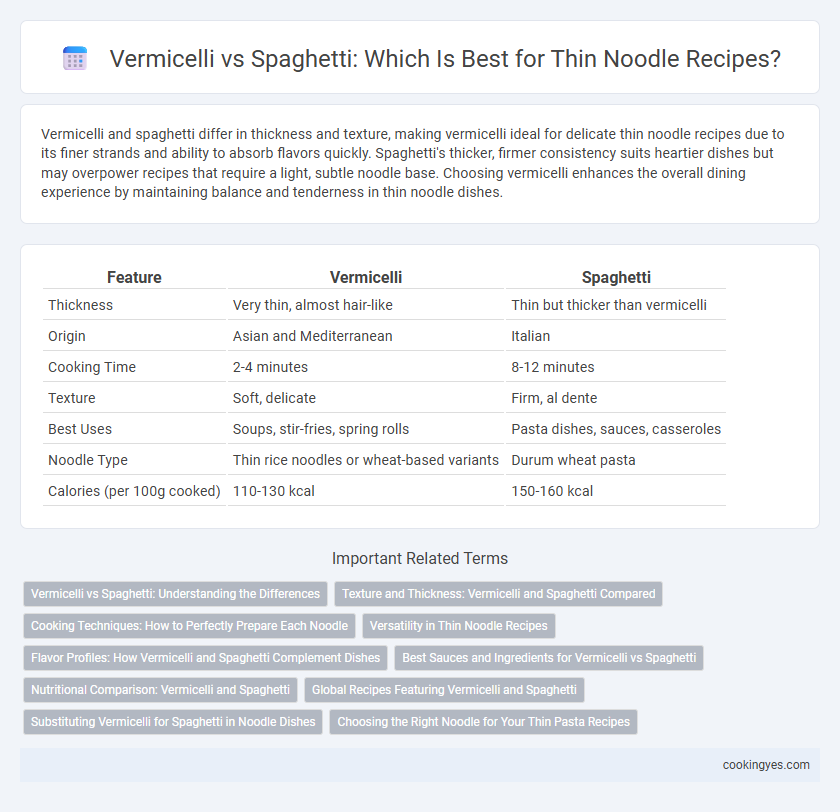Vermicelli and spaghetti differ in thickness and texture, making vermicelli ideal for delicate thin noodle recipes due to its finer strands and ability to absorb flavors quickly. Spaghetti's thicker, firmer consistency suits heartier dishes but may overpower recipes that require a light, subtle noodle base. Choosing vermicelli enhances the overall dining experience by maintaining balance and tenderness in thin noodle dishes.
Table of Comparison
| Feature | Vermicelli | Spaghetti |
|---|---|---|
| Thickness | Very thin, almost hair-like | Thin but thicker than vermicelli |
| Origin | Asian and Mediterranean | Italian |
| Cooking Time | 2-4 minutes | 8-12 minutes |
| Texture | Soft, delicate | Firm, al dente |
| Best Uses | Soups, stir-fries, spring rolls | Pasta dishes, sauces, casseroles |
| Noodle Type | Thin rice noodles or wheat-based variants | Durum wheat pasta |
| Calories (per 100g cooked) | 110-130 kcal | 150-160 kcal |
Vermicelli vs Spaghetti: Understanding the Differences
Vermicelli and spaghetti differ primarily in thickness and culinary uses, with vermicelli being thinner and commonly used in Asian dishes like pho or spring rolls, while spaghetti is thicker and central to Italian cuisine such as pasta with tomato sauces. Vermicelli's delicate texture allows it to cook faster and absorb flavors more readily, making it ideal for light broths and stir-fries. In contrast, spaghetti's sturdier structure supports heavier, cream-based or meat sauces, creating distinct taste and texture experiences in thin noodle recipes.
Texture and Thickness: Vermicelli and Spaghetti Compared
Vermicelli features a thinner and more delicate texture compared to spaghetti, making it ideal for light, broth-based dishes where a subtle bite is preferred. Spaghetti's thicker and firmer structure holds up well in robust sauces and stir-fries, providing a chewier mouthfeel. The variance in thickness directly impacts cooking time and versatility in thin noodle recipes, with vermicelli often requiring less time and offering a finer texture.
Cooking Techniques: How to Perfectly Prepare Each Noodle
Vermicelli requires a brief soaking in hot water or quick boiling, allowing it to become tender without turning mushy, ideal for delicate stir-fries or soups. Spaghetti demands a rolling boil and consistent stirring to avoid sticking, with cooking times typically ranging between 8 to 12 minutes for al dente texture. Mastering precise soaking for vermicelli and timing for spaghetti ensures perfect thin noodle dishes with optimal texture and flavor absorption.
Versatility in Thin Noodle Recipes
Vermicelli offers superior versatility in thin noodle recipes due to its delicate texture and quick cooking time, making it ideal for stir-fries, soups, and salads. Unlike spaghetti, which maintains a firmer bite and pairs best with heavier sauces, vermicelli absorbs flavors readily, enhancing light broths and fresh ingredients. This adaptability makes vermicelli a preferred choice for diverse culinary applications requiring thin noodles.
Flavor Profiles: How Vermicelli and Spaghetti Complement Dishes
Vermicelli's delicate, slightly nutty flavor absorbs sauces quickly, making it ideal for light, aromatic dishes like Asian stir-fries and fresh spring rolls. Spaghetti has a mild wheat taste and firmer texture, complementing robust, tomato-based sauces and Mediterranean flavors. The choice between vermicelli and spaghetti depends on the desired balance between subtlety and heartiness in thin noodle recipes.
Best Sauces and Ingredients for Vermicelli vs Spaghetti
Vermicelli pairs best with light, fresh sauces such as Vietnamese nuoc cham or Thai peanut sauce, perfectly complementing its delicate texture and thin strands. Spaghetti supports heartier sauces like marinara, carbonara, or Bolognese, which cling to its slightly thicker shape, enhancing its bold Italian flavors. Ingredients like fresh herbs, garlic, chili flakes, and lime work well with vermicelli, while olive oil, Parmesan cheese, tomatoes, and ground meat amplify the taste profile of spaghetti dishes.
Nutritional Comparison: Vermicelli and Spaghetti
Vermicelli and spaghetti differ nutritionally, with vermicelli typically made from rice or mung bean starch, offering a gluten-free option low in fat but higher in simple carbohydrates, while traditional wheat-based spaghetti contains more protein and dietary fiber. Vermicelli tends to have fewer calories per serving compared to spaghetti, making it suitable for calorie-conscious diets, whereas spaghetti's complex carbohydrates provide sustained energy release. Both noodles vary in micronutrient content; spaghetti generally contains more iron and B vitamins due to wheat fortification, whereas vermicelli lacks these nutrients unless enriched.
Global Recipes Featuring Vermicelli and Spaghetti
Vermicelli and spaghetti are both versatile thin noodles featured in diverse global recipes, with vermicelli commonly used in Asian dishes such as Vietnamese Pho and Indian Seviyan Kheer. Spaghetti, rooted in Italian cuisine, is iconic in recipes like Spaghetti Carbonara and Spaghetti Aglio e Olio. Their distinct textures and regional culinary applications highlight their unique roles in thin noodle preparations worldwide.
Substituting Vermicelli for Spaghetti in Noodle Dishes
Substituting vermicelli for spaghetti in thin noodle recipes works well due to vermicelli's finer, more delicate texture, allowing it to absorb flavors quickly and blend seamlessly with sauces and ingredients. Vermicelli's shorter cook time and lighter bite often enhance dishes traditionally made with spaghetti, especially in Asian-inspired noodle bowls or soups. When replacing spaghetti, adjust cooking times and sauce consistency to maintain the dish's overall balance and mouthfeel.
Choosing the Right Noodle for Your Thin Pasta Recipes
Vermicelli offers a lighter, more delicate texture compared to spaghetti, making it ideal for thin noodle recipes that require quick cooking and subtle flavor absorption. Spaghetti's thicker strands provide a chewier bite and can hold heartier sauces, which may overpower dishes designed for thin noodles. Selecting vermicelli enhances the authenticity and balance of recipes like Asian stir-fries or light pasta salads, where noodle finesse is crucial.
Vermicelli vs spaghetti for thin noodle recipes Infographic

 cookingyes.com
cookingyes.com